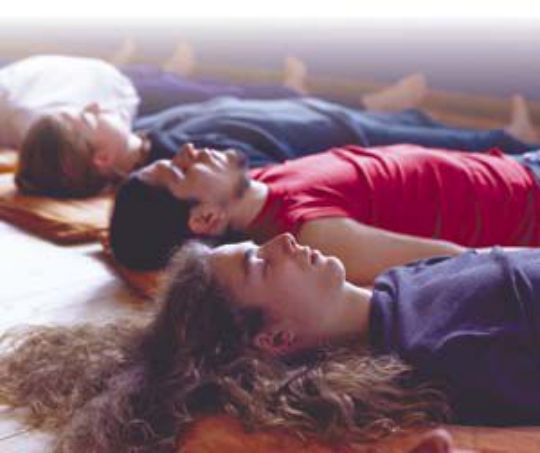Yoga Nidra
The person is guided through mental meditation and relaxation exercises (concentrating on a part of the body, breathing, repeating a mantra, visualization...).
Improves sleep quality
Regeneration improves health
Better management of stress and emotions
Gradually leads to letting go

Before listening and practising with the audio files below
What is Yoga Nidra?
Little-known because it's rarely taught in studios, yoga Nidra is often called "sleep yoga". It is most often practised lying on the floor in "Savasana". The teacher guides the student through meditation and relaxation exercises, which are performed mentally (concentrating on a part of the body, on breathing, repeating a mantra, visualization, etc.).
The aim is to remain conscious (but we'll forgive you if you fall asleep) and, above all, immobile, to encourage concentration. During the exercise, the mind gradually sinks into a state of semi-awakening. And you emerge in top form. It's true!
So, what are the benefits?
1/ Improving sleep
Yoga Nidra brings the practitioner into a state of deep relaxation, making it easier to unwind at bedtime. For those who have trouble falling asleep at night, this form of meditation is surely the answer.
2/ Taking care of your health
Sleep deprivation can lead to symptoms such as depression, weight gain/loss and certain chronic illnesses. Nothing good comes from bad sleep! Forget the adage "I'll sleep when I'm dead"! Your body needs to recharge its batteries to prepare for a new day! If you don't get enough sleep, your immune system is weakened. When you know that a thirty-minute session of Yoga Nidra is equivalent to a two-hour sleep cycle, you'll be glad you did!
3/ Better stress and emotional management
Meditation exercises - especially those that direct the mind towards body awareness and breath awareness - enable you to connect with yourself. By focusing attention on these areas, we can leave behind the little worries of everyday life.
4/ Letting go
When we're awake, we're constantly trying to position ourselves in a state of control. We make decisions, we sometimes make efforts. As soon as an uncontrollable event occurs, impatience and, sometimes, anger set in. During a yoga Nidra session, we no longer try to control what happens: we let ourselves be guided by the teacher's voice. We're drawn into a half-sleep, at peace with ourselves. For a few moments, we stop trying to control everything: we let go, we let go.
5/ Regenerating
Practised in the middle of the day (or late afternoon), yoga Nidra allows us to regenerate both physically and mentally. You'll avoid that late-afternoon slump. In better shape for the day's activities, we're more serene and rested
Personally, I've noticed that I work much better after a yoga Nidra session!
Trataka
Trataka is a meditation technique that involves focusing the eyes (and in turn the mind) through an intentional but relaxed gaze. Initially, this practice is performed with the eyes open on an external object. It then progresses to internal practice (eyes closed) and emptiness. Sometimes it's called tratak or tratika. In all forms of trataka, you can incorporate breath awareness or mantra repetition if you find it useful, although it is not usually taught in this way.
The following benefits are attributed to trataka:
Improves concentration, memory and willpower
Improves visualization skills
Improves cognitive function
Cures eye diseases
Makes eyes stronger, clearer and brighter
Helps insomnia
Clears accumulated mental/emotional complexes
Brings suppressed thoughts back to the surface
Increases nervous stability
Calms the restless mind
Balances activity in both hemispheres of the brain
Improves vision in the dark (if practiced over a candle flame)
Calming effect on the central nervous system
Increases self-confidence and patience